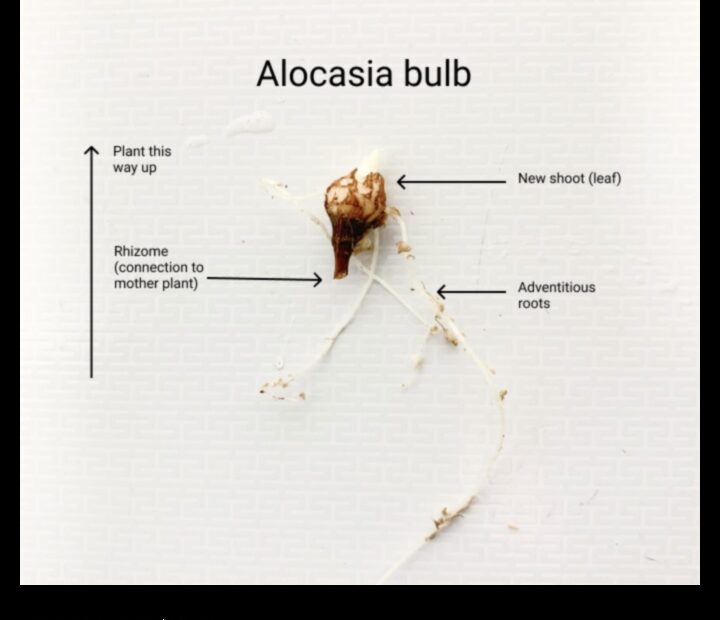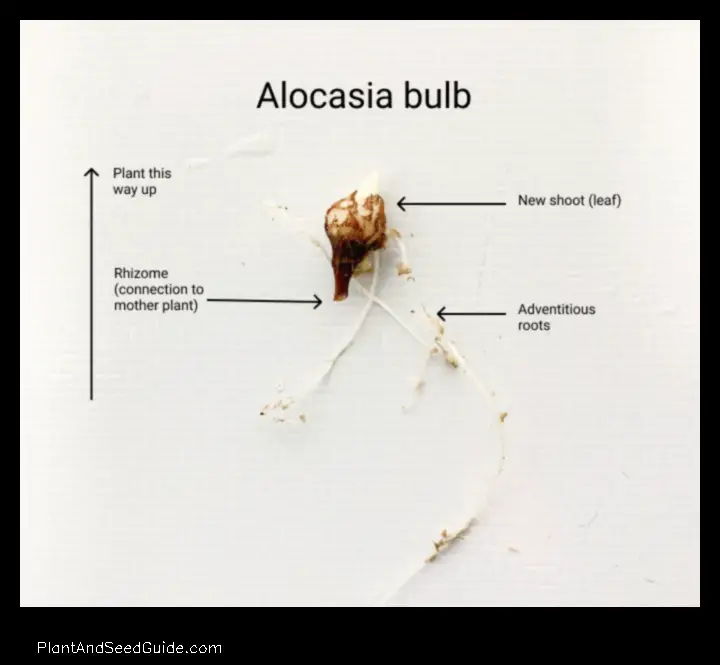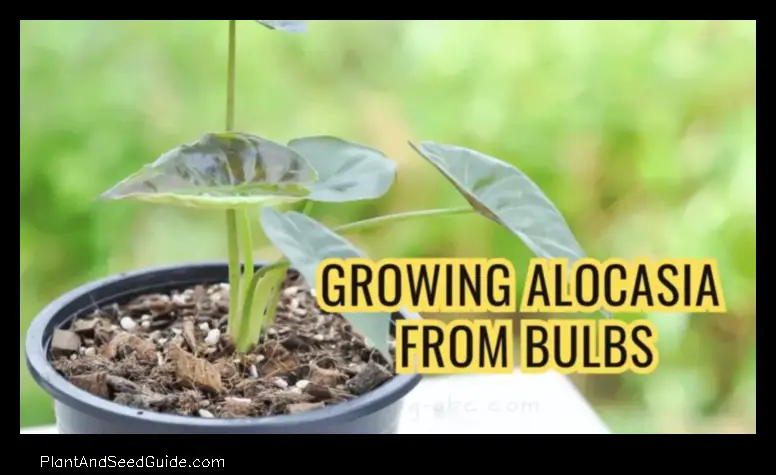

Alocasia Bulb Planting
IWhat is an Alocasia Bulb?
How to Choose the Right Alocasia Bulb
When to Plant Alocasia Bulbs
Where to Plant Alocasia Bulbs
VHow to Care for Alocasia Bulbs
Troubleshooting Alocasia Bulb Problems
Alocasia Bulb Pests and Diseases
Alocasia Bulb Companion Plants
FAQ
| Topic |
Features |
| Alocasia Bulb |
– Grows in USDA hardiness zones 8-11
| – Prefers bright, indirect sunlight
| – Needs well-draining soil
| – Water regularly, but do not overwater
Loading... Seconds Left for
Miniature Orchid Terrarium Gallery!

| – Fertilize monthly during the growing season
|
| Alocasia Care |
– Repot every 2-3 years
| – Prune as needed
| – Propagate by division or stem cuttings
| – Protect from pests and diseases
|
| Alocasia Planting |
– Plant bulbs in the spring or early summer
| – Dig a hole that is twice the diameter of the bulb
| – Plant the bulb so that the top is just below the soil surface
| – Water well after planting
|
| Alocasia Propagation |
– Divide the plant in the spring or early summer
| – Take stem cuttings in the summer or fall
| – Sow seeds in the spring
|
| Alocasia Varieties |
– Alocasia amazonica
| – Alocasia baginda
| – Alocasia macrorrhiza
| – Alocasia odora
| – Alocasia reginula |

An alocasia bulb is a type of corm, which is a swollen underground stem that stores food and nutrients. Alocasia bulbs are typically round or oval in shape, and they can range in size from a few centimeters to several inches in diameter. The outer skin of the bulb is usually brown or black, and the inner flesh is white or yellow.
Alocasia bulbs are produced by alocasia plants as a means of reproduction. When the conditions are right, the bulb will sprout a new plant. Alocasia bulbs can be planted in the spring or summer, and they will typically flower in the fall or winter.
Alocasia bulbs are a popular choice for home gardeners because they are easy to grow and care for. They are also relatively pest– and disease-resistant.
How_to_Choose_the_Right_Alocasia_Bulb">How to Choose the Right Alocasia Bulb
When choosing an alocasia bulb, there are a few things to keep in mind.
- The size of the bulb. Alocasia bulbs come in a variety of sizes, from small to large. The size of the bulb will determine the size of the plant.
- The shape of the bulb. Alocasia bulbs can be round, oval, or oblong. The shape of the bulb will affect the appearance of the plant.
- The color of the bulb. Alocasia bulbs can be white, yellow, green, or purple. The color of the bulb will add to the overall appearance of the plant.
- The type of alocasia. There are over 70 different species of alocasia, each with its own unique characteristics. The type of alocasia will determine the size, shape, color, and care requirements of the plant.
Once you have considered these factors, you can choose the right alocasia bulb for your home.
When_to_Plant_Alocasia_Bulbs">When to Plant Alocasia Bulbs
The best time to plant alocasia bulbs is in the spring, after the last frost. However, you can also plant them in the fall, as long as they are given plenty of time to establish themselves before the ground freezes.
When planting alocasia bulbs, it is important to choose a location that receives bright, indirect sunlight. The soil should be well-draining and rich in organic matter.
To plant alocasia bulbs, dig a hole that is twice the diameter of the bulb. Place the bulb in the hole, with the pointed end facing up. Cover the bulb with soil and water thoroughly.
Alocasia bu
lbs will typically sprout within a few weeks. Once the plants have started to grow, you can begin to fertilize them with a balanced fertilizer.
Alocasia bulbs are relatively easy to care for, and they make beautiful additions to any garden. With proper care, your alocasia plants will thrive and provide you with years of enjoyment.
Where to Plant Alocasia Bulbs
Alocasia bulbs can be planted in a variety of different locations, both indoors and outdoors. Some of the most popular places to plant alocasia bulbs include:
Indoors
/>
Alocasia bulbs can be planted in pots or containers, or in the ground in a sheltered location. When planting alocasia bulbs indoors, it is important to choose a pot or container that is at least 12 inches deep and wide. The soil should be well-draining and rich in organic matter. Alocasia bulbs should be planted about 2 inches deep, with the pointed end facing up.
Alocasia bulbs can also be planted in the ground in a sheltered location, such as under a tree or in a shady spot. The soil should be well-draining and rich in organic matter. Alocasia bulbs should be planted about 2 inches deep, with the pointed end facing up.
Outdoors
Alocasia bulbs can be planted in the ground in a sunny location. The soil should be well-draining and rich in organic matter. Alocasia bulbs should be planted about 2 inches deep, with the pointed end facing up.
Alocasia bulbs can also be planted in pots or containers, or in the ground in a sheltered location.When planting alocasia bulbs outdoors, it is important to choose a pot or container that is at least 12 inches deep and wide..
The soil should be well-draining and rich in organic matter. Alocasia bulbs should be planted about 2 inches deep, with the pointed end facing up.
When choosing a location to plant your alocasia bulbs, it is important to consider the following factors:
Sunlight: Alocasia bulbs need bright, indirect sunlight to thrive. They will not do well in full sun, as this can scorch the leaves.
Water: Alocasia bulbs need regular watering, but they should not be overwatered. The soil should be moist but not soggy.
Temperature: Alocasia bulbs prefer warm temperatures, between 65 and 85 degrees Fahrenheit. They will not do well in cold weather.
Humidity: Alocasia bulbs prefer high humidity levels. If the humidity is too low, the leaves may wilt.
By consider
ing these factors, you can choose the best location to plant your alocasia bulbs and ensure that they thrive.
VHow to Care for Alocasia Bulbs
Alocasia bulbs are relatively easy to care for, but there are a few things you can do to ensure that your plants stay healthy and happy.
Here are some tips for caring for alocasia bulbs:
- Water your alocasia bulbs regularly, but make sure not to overwater them. The soil should be moist but not soggy.
- Fertilize your alocasia bulbs monthly with a balanced fertilizer.
- Alocasia bulbs prefer bright, indirect sunlight. If you live in a sunny area, you may need to provide your plants with some shade during the hottest part of the day.
- Alocasia bulbs are not cold-hardy, so they should be brought indoors during the winter months.
If you follow these tips, your alocasia bulbs should thrive and produce beautiful foliage for years to come.
Troubleshooting Alocasia Bulb Problems
If you are having trouble growing alocasia bulbs, there are a few things you can check to troubleshoot the problem.
- The soil is too wet or dry. Alocasia bulbs need moist soil, but not soggy soil. If the soil is too wet, the bulbs can rot. If the soil is too dry, the bulbs can dry out and die.
- The temperature is too cold or hot. Alocasia bulbs prefer warm temperatures, between 65 and 85 degrees Fahrenheit. If the temperature is too cold, the bulbs can go dormant. If the temperature is too hot, the bulbs can scorch.
- The light is too bright or too dim. Alocasia bulbs need bright, indirect light. If the light is too bright, the leaves can burn. If the light is too dim, the leaves can become leggy and weak.
- The plant is not getting enough water. Alocasia bulbs need to be watered regularly, especially during the growing season. If the plant is not getting enough water, the leaves will wilt and the plant may die.
- The plant is not getting enough fertilizer. Alocasia bulbs need to be fertilized regularly, especially during the growing season. If the plant is not getting enough fertilizer, the leaves will become yellow and the plant may not bloom.
If you have checked all of these factors and the plant is still not thriving, you may need to consult with a gardening expert.
Alocasia Bu
lb Pests and Diseases
Alocasia Bulb Pests and Diseases
Alocasia bulbs can be susceptible to a variety of pests and diseases, including:
- Aphids
- Mealybugs</li>
- Scale insects
- Thrips
- Whiteflies
- Fungus gnats
- Root rot
- Bacterial leaf spot
- Rust
If you suspect that your alocasia bulb is infested with pests or diseases, it is important to take action to treat the problem before it spreads to other plants.
Here are so
me tips for preventing and treating pests and diseases on alocasia bulbs:
- Inspect your plants regularly for signs of pests or diseases.
- Isolate any infected plants from the rest of your collection.
- Use insecticidal soap or neem oil to kill pests.
- Treat fungal diseases with a fungicide.
- Water your plants regularly and provide them with good drainage to help prevent root rot.
By fo
llowing these tips, you can help keep your alocasia bulbs healthy and pest-free.Alocasia Bulb Companion Plants
Alocasia bulbs can be grown in a variety of different containers, but they do best when they are planted with other plants that have similar water and light requirements. Some good companion plants for alocasia bulbs include:
- Anthuriums
- Peace lilies
- Philodendrons
- Monsteras
- Scheffleras
These plants all thrive in bright, indirect light and moist soil, so they will make good companions for alocasia bulbs. When planting these plants together, it is important to make sure that they have enough space to grow. Alocasia bulbs can grow quite large, so it is important to give them plenty of room to spread out.
It is also important to make sure that the plants are compatible with each other’s watering needs. Alocasia bulbs need to be watered regularly, but they should not be allowed to sit in waterlogged soil. The other plants listed above also need to be watered regularly, but they can tolerate a bit more moisture than alocasia bulbs.
By planting
alocasia bulbs with other plants that have similar water and light requirements, you can create a beautiful and thriving garden that is easy to care for.
FAQ
Q: What is an Alocasia bulb?
A: An alocasia bulb is a type of corm, which is a swollen stem that stores food and nutrients.
Alocasia bulbs are typically round or oval in shape and can be white, yellow, or brown in color..
They are typically about 2-3 inches in diameter.
Q: How to choose the right Alocasia bulb?
A: When choosing an alocasia bulb, it is important to consider the following factors:
The size o
f the bulb. The size of the bulb will determine the size of the plant.
The color of the bulb. The color of the bulb will determine the color of the leaves.
The variety of the bulb. There are many different varieties of alocasia bulbs, each with its own unique characteristics.
Q: When to plant Alocasia bulbs?
A: Alocasia bulbs can be planted in either spring or fall. Spring is the best time to plant alocasia bulbs in most climates, as the weather is warm and the soil is moist. However, alocasia bulbs can also be planted in fall in colder climates, as the bulbs will have time to grow roots before the ground freezes.
_posts">Recent PostsHello, I'm Katie Owen! I am the voice behind "plantandseedguide," inviting you on a journey through the enchanting world of greenery. The magical beauty of nature and the fascinating realm of plants have always captivated me, leading me to this space.
Latest posts by Katie Owen
(see all)


